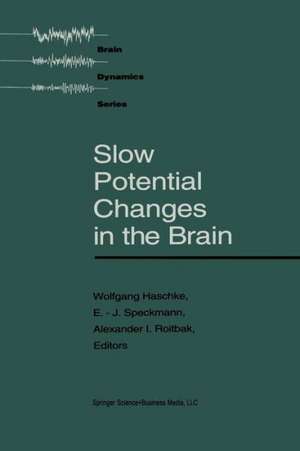Slow Potential Changes in the Brain: Brain Dynamics
Autor Haschke, Speckmannen Limba Engleză Paperback – 7 noi 2012
Preț: 389.11 lei
Nou
Puncte Express: 584
Preț estimativ în valută:
74.46€ • 79.62$ • 62.08£
74.46€ • 79.62$ • 62.08£
Carte tipărită la comandă
Livrare economică 17 aprilie-01 mai
Preluare comenzi: 021 569.72.76
Specificații
ISBN-13: 9781475713817
ISBN-10: 1475713819
Pagini: 312
Ilustrații: XXII, 288 p. 93 illus.
Dimensiuni: 155 x 235 x 16 mm
Greutate: 0.44 kg
Ediția:Softcover reprint of the original 1st ed. 1993
Editura: Birkhäuser Boston
Colecția Birkhäuser
Seria Brain Dynamics
Locul publicării:Boston, MA, United States
ISBN-10: 1475713819
Pagini: 312
Ilustrații: XXII, 288 p. 93 illus.
Dimensiuni: 155 x 235 x 16 mm
Greutate: 0.44 kg
Ediția:Softcover reprint of the original 1st ed. 1993
Editura: Birkhäuser Boston
Colecția Birkhäuser
Seria Brain Dynamics
Locul publicării:Boston, MA, United States
Public țintă
ResearchCuprins
Introductory Remarks.- 0 What is a Generator Like?.- I. Overview.- 1 DC Potentials of the Brain.- 2 Activity of Single Neurons and Their Relationship to Normal EEG Waves and Interictal Epilepsy Potentials in Humans.- II. Psychophysiology.- 3 Determinants of CNV Amplitude.- 4 Changes of Slow Brain Potential Shifts Following Failure.- 5 Association Cortex Contributions to the Human P3.- 6 Interactions between the DC Potential of the Brain and Slow Potential Shifts under Mental Load.- 7 The “Oddball CNV” as Indicator of Information Processing in Healthy Subjects and Patients with Panic Disorders.- 8 Lateralization of Slow Brain Potentials and Preparatory Processes.- III. Neurophysiology.- 9 The Genesis of Cortical Event-Related Potentials: Excitatory and Inhibitory Contributions.- 10 Prolonged Unstable Depression: A Modified Manifestation of Spreading Depression in Rat Hippocampus.- 11 Modulation of Glutamate Responses by Noradrenaline and GABA in Neo- and Archicortical Structures.- 12 Extracellular Changes of Aspartate, Glutamate, and Taurine in Relation to DC Changes during Complete Cerebral Ischemia and Cortical Spreading Depression.- 13 Evoked Field Potentials—Beyond Correlates of Behavior: An Approach to Determining the Neural Mechanism of Behavior.- IV. Glia and Microenvironment.- 14 Cortical Slow Potentials, Depolarization of Glial Cells, and Extracellular Potassium Concentration.- 15 Voltage- and Ligand-Gated Membrane Currents of Identified Glial Cells in the Hippocampal Slice.- 16 Contributions of Extracellular Potassium Increases to Transient Field Potentials (Review of Data).- 17 Cornea-Negative and Cornea-Positive Slow Components of the ERG and Light-induced Extracellular Potassium Changes.- V. Biomagnetism.- 18 Magnetoencephalographic Signals and TheirRegistration.- 19 Neuromagnetism and Source Location.- 20 Measurement of Neuromagnetic Signals.- 21 Extracranial Slow Magnetic Field Changes during Epileptic Activity.- VI. Motor Control.- 22 DC Shifts and Event-related Potentials Associated with Workload in a Dual Task Situation.- 23 Frontomesial Activation during Spatial Bilateral Coordination: Tentative Conclusions on SMA Function.- 24 Phasic and Tonic Changes of the Mean Alpha Frequency (MAF) of the EEG during Motor Performance.- 25 Changes of CNS Activation Patterns during Motor Imagination.














